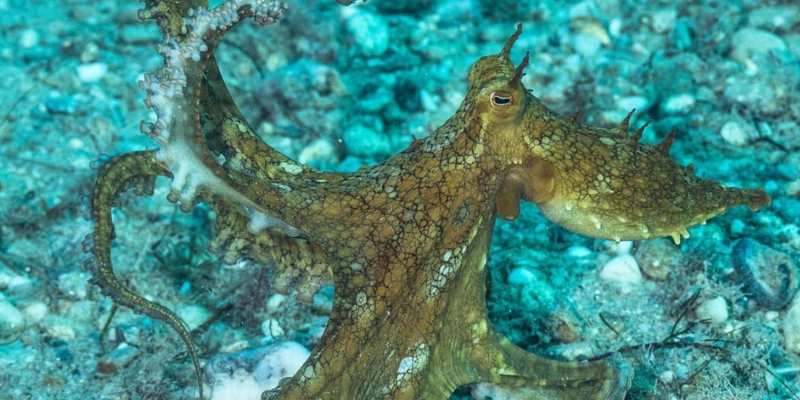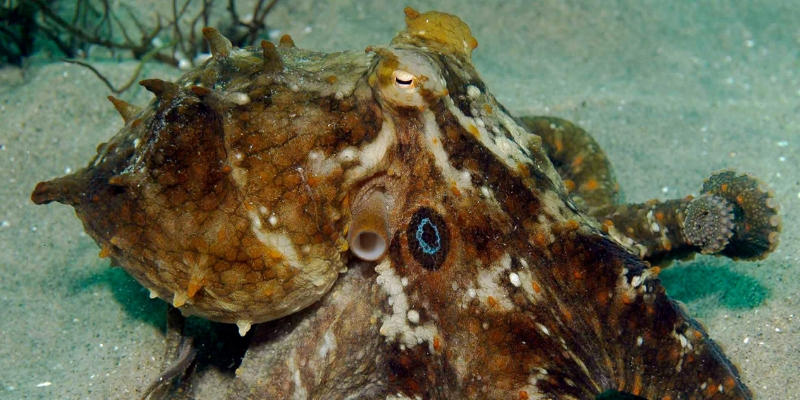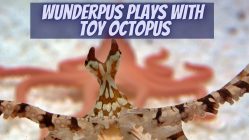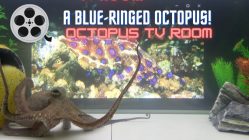
Okay, when you first hear “bimac” your mind may start associating it as a new burger product from McDonald’s. Maybe they rebranded the “Big Mac.” When you hear the words “bimac” and “octopus” in tandem, you may think its some new kind of seafood sandwich on their menu meant to replace the “Filet-o-Fish.”
All joking aside, the bimac octopus is one of the common names of the Octopus bimaculoides. Yes, “bimac” came about as a shortened version of “Octopus bimaculoides” because let’s be honest, who wants to pronounce “bimaculoides” more than once? The species is also known as the California two-spot octopus.
Bimac Octopus Facts
- Scientific Name : Octopus bimaculoides
- Common Name: Bimac Octopus
- Size: 2 feet (23 inches)
- Weight: 2 – 4 kg
- Lifespan: average 2 years
- Found in: coast of California – Baja California
- Sub-Order: Incirrina
- Discovered: 1949
- Scientific Name : Octopus bimaculoides
- Common Name: Bimac Octopus
- Size: 2 feet (23 inches)
- Weight: 2 – 4 kg
- Lifespan: average 2 years
- Found in: coast of California – Baja California
- Sub-Order: Incirrina
- Discovered: 1949
To the novice observer of the bimac octopus, this can make identifying the natural coloration of the species difficult. When this species of octopus is observed in a neutral setting, they will normally take on a grayish coloration accented with a few yellowish spots.
—Where is the Bimac Octopus Found?—

The bimac octopus is found in the relatively shallow water off the coast of California and Baja California. Its southern reach into Baja only covers the western coast of that peninsula. The bimac octopus is not found on the eastern shore of the peninsula in the Sea of Cortez.
The bimac octopus is usually found in intertidal depths and as deep as 60 feet below the surface.
In terms of habitat, the bimac prefers areas on the seafloor that offer plenty of nooks and crevices. This makes rocky reefs the mainstay for the bimac.
Unlike other octopus species, the babies of the Bimac Octopus are benthic, which means that they live on the bottom of the sea from the moment they come out of their eggs.
—What Water Temperature Does the Bimac Octopus Prefer?—

Being a species that is exclusive to the California coast coupled with its fondness for shallow water, it should be no surprise that the bimac octopus has evolved to prefer warmer water. The comfortable temperature zone for the bimac ranges from 60 to 80 degrees Fahrenheit. That is a broader range than other species.
—How Big Does the California Two-Spot Octopus Get?—
In terms of overall size, the bimac octopus is on the medium to smaller end of the size spectrum. It has a mantle — the bulbous head portion — that measures between 6 to 8 inches. Its arms can reach lengths of two feet.
—Appearance—

The profile of the bimac octopus is slick. Like nearly all of the 300 octopus species, the California two-spot octopus has the ability to change colors in order to match its surrounding area. Special muscles on its skin also allow it to match the texture of the surroundings.
To the novice observer of the bimac octopus, this can make identifying the natural coloration of the species difficult. When this species of octopus is observed in a neutral setting, they will normally take on a grayish coloration accented with a few yellowish spots. Other specimens have been seen to take a pinkish to orangeish tone under neutral conditions.
The most distinctive features of this species of octopus are the two large blue spots on its head. They are located one beneath each of the eyes.
The tone of the blue coloration can vary from a dark blue to a lighter shade. It is believed that this feature evolved in order to make the smaller octopus look more ominous. While a predator would be able to discern its small size while in the open, if a predator were to come along while the bimac octopus is in its den, the two spots make it appear as if it were the head of a much larger creature. That is enough to dissuade some predators.
—Diet—

This octopus combines both active and passive hunting styles. This means that they are comfortable in seeking out prey and using a pouncing-like technique to capture it. They are equally as comfortable to remain camouflaged or hidden in there den waiting for potential prey to come their way.
On average, the bimac octopus will hunt in some capacity twice a day. If prey is abundant, they will easily feed twice as often.
Another aspect about the California two-spot octopus’ diet that has been observed is that when it has a variety of prey at its disposal, it will tend to opt for those creatures which have a higher level of amino 3 fatty acids. In other words, if given a choice it will select the option with the highest fat content and calories.
—Behavior—

The bimac octopus can be classified as an inquisitive and friendly creature — even by octopus standards.
In observation of this species in the wild, it has been established that it spends more time in the open compared to other octopuses of similar size and habitat preferences.
While the majority of its time is spent in its dwelling — which normally consists of a crevice or other secluded opening along the seafloor — it does spend a great deal of its time perched in the open.
Of course, the bimac octopus is not out there looking for trouble. It is not in the open to scare away prey or attract predators. The time that it does spend perched in the open is under the guise of its camouflage.
In captivity, the bimac octopus has demonstrated tolerance for having other octopuses nearby. That is not a trait that is shared by many other species. The majority of octopus species prefer solitary conditions and would be stressed by the presence of another octopus. It could even lead to aggression and violence.
As passive as the bimac octopus is, if you intend on having a bimac octopus in an aquarium it is still best to keep only one per tank.
—Behavior—

The lifespan of the bimac octopus is between 1 to 2 years. This tends to fluctuate based on climatological conditions in the wild. Usually, the more ideal the environmental conditions at any given point in time, the more rapidly that the bimac octopus will enter its breeding cycle.
In turn, it is the act of breeding which ushers in the end of the bimac octopus’ lifespan. Males will die a few weeks after breeding. Females will die shortly after her eggs have hatched.
In captivity, even when breeding never takes place, it is rare for this species of octopus to live more than two years.
—Small, Friendly, and Beautiful—
In short, the bimac octopus is accurately described as a small, friendly, and beautiful cephalopod. Smart as it is curious, cautious as it is friendly, this species of octopus puts forth the best qualities of shallow-water octopuses.
—The Bimac Octopus, a Great Pet Choice—
The California Two-Spot Octopus is an extremely popular choice for a pet octopus, and for a good reason. Thanks to its blue spots, it is simply captivating to watch and spending more time in the open means more time for you to show your beautiful pet off to your friends.
As mentioned below, the Bimac Octopus prefers warm waters, ideally around 65 degrees Fahrenheit. A 50 gallons tank is sufficient to keep your Bimac Octopus happy, but if you have the space and means to provide an even bigger tank, go ahead.











